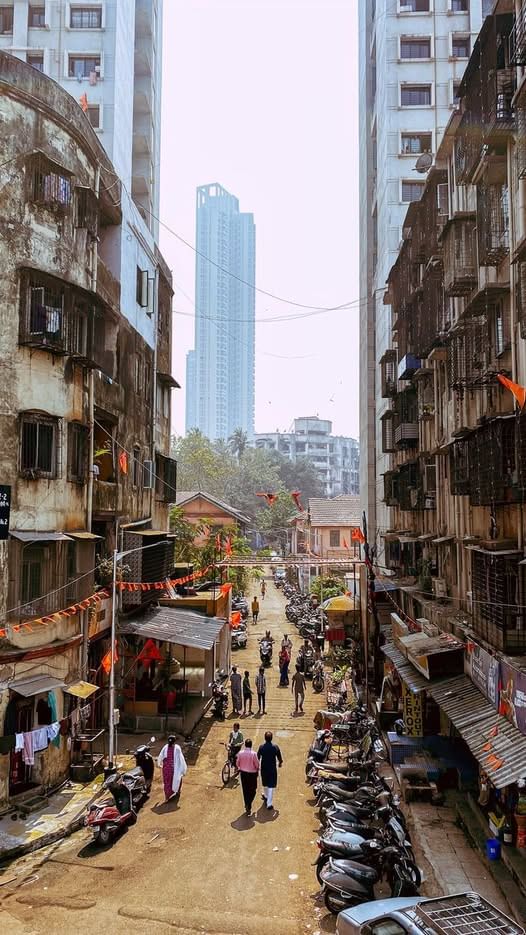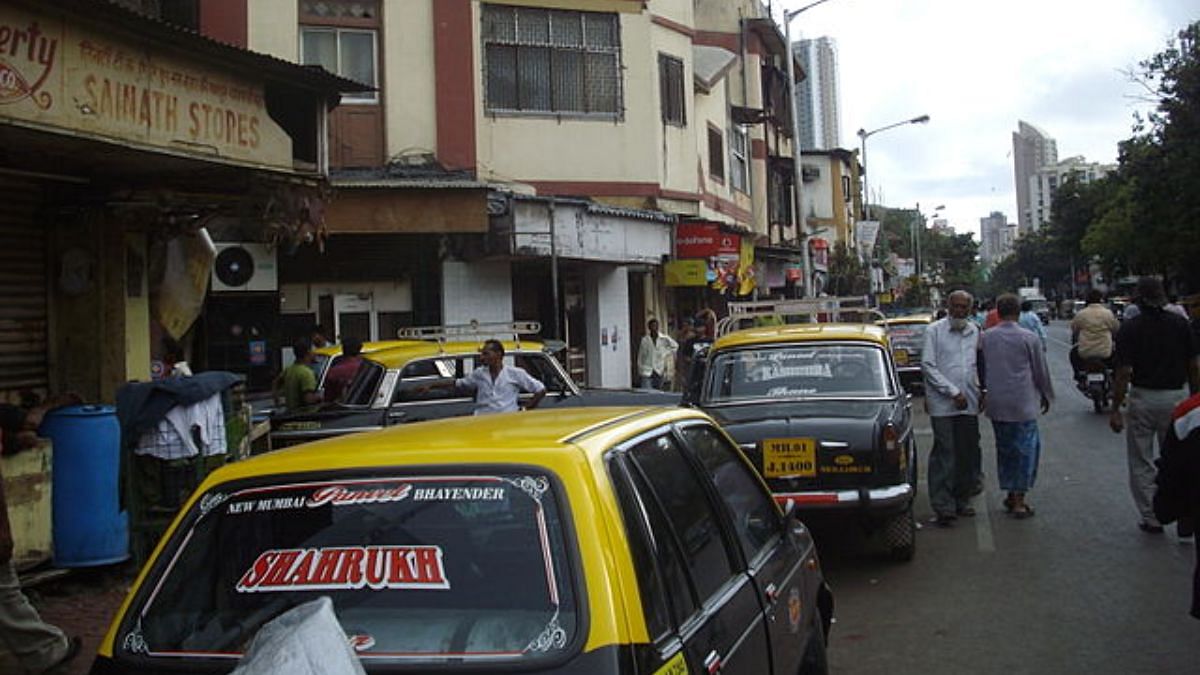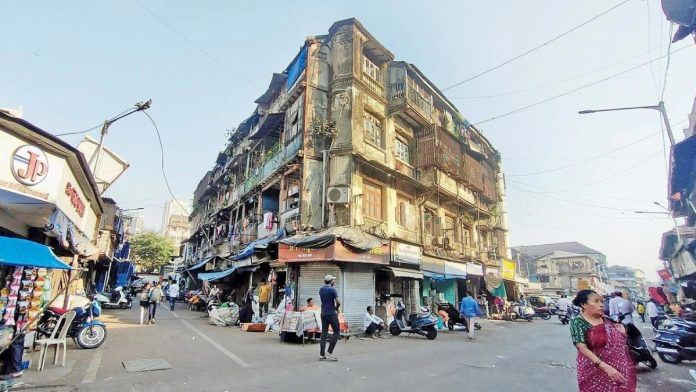Mumbai: For nearly two decades, residents of Kamathipura—a congested, decrepit South Mumbai neighbourhood known for its crumbling, cubbyhole houses—have been waiting for redevelopment that could bring modern housing and amenities to their lives. Locals have been trying to bring in a developer to turn the area into a planned colony since 2007.
But the project could not make any headway due to two major hurdles—bureaucratic red tape and Kamathipura’s notoriety. A microcosm of the city’s working-class population, the area has long been almost synonymous with Mumbai’s sex workers’ industry.
After 18 long years, however, Kamathipura is finally on the brink of a makeover. The Maharashtra Housing and Area Development Authority (MHADA) has zeroed in on a developer, paving the way for the neighbourhood’s long-awaited transformation under the state’s cluster redevelopment scheme.
Residents have begun to see a glimmer of hope that their colony may finally shed its infamous identifier—‘Mumbai’s red-light district’.
The neighbourhood’s sex workers have not been included in the redevelopment blueprint. In fact, there are no plans for them as of now.
Most residents are unconcerned about their fate, focusing instead on how the area will soon become more ‘family-friendly’.
Speaking to ThePrint about challenges the families face, Lata Tuma—who has lived in Kamathipura for three decades and is now in her 50s—says, “Nobody wants to marry their daughter into Kamathipura.”
She had no choice, she adds, since her parents chose her husband, who lived in a 60-square-foot house in Kamathipura. But now, as she looks for a wife for her son, nobody seems interested, she rues. The redevelopment, however, has made her hopeful—she believes it will help rewrite the story of the neighbourhood.
Like many others, Tuma also dreams of a bigger home. “My house is so small that even if you take two steps, you can cover the entire place. If anyone goes to the washroom, others have to wait outside. At a time, only two people can have meals. Once done, two others can sit. It’s difficult to live like this,” she says.
Under the redevelopment project, the matchbox houses—currently between 60 and 180 square feet—will be replaced by 500-square-foot, self-contained units in modern high-rises.

Last month, MHADA received two bids to revamp Kamathipura—one from AATK Constructions and another from J. Kumar Infraprojects. After scrutiny, the housing authority finalised AATK Constructions. The tender now awaits approval from the state’s high-powered committee for cluster redevelopment, after which it will be placed before the state cabinet for final clearance.
“The discussions around this project have been going on for a long time. But finally, the moment has arrived. It’s an important project and a milestone for us as well,” a senior MHADA official told ThePrint.
ThePrint also reached out to MHADA CEO Sanjeev Jaiswal, but he has not responded so far. This report will be updated if and when he does.
The sex trade in Kamathipura has been declining, with its years of flourishing activity now far behind. A local survey found that only around 1,200 sex workers currently operate in the area, most of them without proper documentation or proof of residence. As a result, they are ineligible for rehabilitation under the cluster redevelopment project.
“Nobody has thought about them,” say social workers—the only ones concerned about the displacement of sex workers because of the redevelopment.
“Many of them come from outside to work here, so they will not be considered eligible for housing. They are worried about where they will go from here. Some say they’ll return to their villages, but it’s not easy. We plan to speak to the authorities about them,” said Rupa Metugu, president of Asha Mahila Sanstha, an NGO working in the area.
Commenting on the issue, the MHADA official told ThePrint, “Those who have documents to show, we will definitely accommodate them in a separate building. But such people are very few.”
Also Read: Amid ‘fake voter’ row, Maharashtra EC moves ahead with civic polls, promises electoral roll cleanup
Infamy of Kamathipura
Many Telugu-speaking construction workers and labourers, including artisans, migrated from the Nizam-ruled Hyderabad to Mumbai during the late 18th century. Known as ‘kamathis’, they arrived in Mumbai and tried to settle on a marshy plot, which would later become Kamathipura.
But not just the Telugu-speaking population, the area has housed people from different backgrounds and cultures. The textile mill workers, predominantly Marathi-speaking, the Gujaratis, the North Indians, and people belonging to the working and labouring classes had settled in the area. Still earlier, Chinese residents who worked at the dockyards and restaurants had walked back home through Kamathipura’s lanes.
In the late 1950s, the residents were an integral part of the ‘Samyukt Maharashtra’ movement, demanding statehood.

As the neighbourhood grew in its population density, the sex trade too flourished in some lanes. On the ‘Shuklaji’ Street, women clad in glittery clothes became a regular sight. The neighbourhood soon came to be known as ‘Mumbai’s red light area’. Since then, it has featured in popular culture, having inspired several Bollywood films.
Called ‘safed gully (white lane)’ because of European sex workers who operated in the area during Colonial times, Kamathipura is also where the opium trade had flourished. Alcohol, music, ‘mujra’, and the fragrance of ‘mogra’ had once filled its air, drawing in people.
However, this is now a part of Kamathipura’s past. The brothels—prominent till the turn of the century—have now given way to shops, markets, and recycled scrap.
“Now, Kamathipura is only called the ‘red light area’, for the sake of it. It [the trade] is now only in four lanes of Kamathipura. It has dwindled considerably. Only those who have been living here for many generations—only they have continued to live here. And even they are looking into different trades now,” says a local activist, Kishorkumar Tiwari.
Chaya Jagtap, who works for an NGO known as Prerna, said that most sex workers arrived in Kamathipura looking for work without having any accommodation there. Now, a few of the women also have children living with them. But Jagtap insists that the women are prepared to shift for the redevelopment project.
And, it is not like they have an option.
“They have heard about this, but there are still a few years before the entire area is redeveloped. So, once they are asked to leave, they will have to leave…Since there is no legal right over the house, they will have to move out,” says Jagtap.
Long wait for revamp
Congress MLA Amin Patel was among the first to push for the redevelopment of Kamathipura in 2007, but developers were hesitant to come forward.
Only one realtor, DB Realty, came forward then, but soon after, it faced financial constraints and quickly backed out. And so, the project was put on the back burner, said Patel.
“I have worked on this project for the last 14 years. Rigorously, daily, that is why we are seeing this day, today,” Patel says.
Patel says when the Maha Vikas Aghadi government came to power, it decided to bring MHADA into the picture and made it the nodal authority for the redevelopment project.
However, the project moved slowly. There was confusion over whether the housing department or the urban development department would undertake it, says Patel.
When the Mahayuti government came to power in January 2023, it approved the Kamathipura cluster redevelopment project. But it was, once again, pushed to the back burner, only to be revived this year.
Earlier this year, the government floated tenders through the construction and development model under which a private builder will execute the project under MHADA supervision.
Also Read: Mumbai’s next planned infra boost: A 70-km tunnel network within the city to ease bottlenecks
Challenges in project

Kamathipura Vikas Samiti treasurer Sachin Karpe says the project is now off the drawing board as a result of “14 years of penance” by them. Vikas Samiti is a body of residents that advocates for the redevelopment project.
“We first tried to go via private developers, but nobody was ready to touch the project,” Karpe says, adding that the nuances of tenant vs landowner, and the land title, considering most of the properties were ancestral, took a lot of time to iron out.
The MHADA official says convincing people for the cluster redevelopment was a challenge.
“Redevelopment, building by building, was not feasible in Kamathipura, and this had to be done through cluster redevelopment only. Besides, the issues of landowners and land titles were time-consuming to sort,” the official says.
However, Kamathipura Vikas Samiti, which has been working for many years, stresses that many people also really wanted the redevelopment.
Sangeeta Gajelli, a 55-year-old woman who has lived in the area since her birth, tells ThePrint that even her parents and in-laws were born in Kamathipura itself.
Owner of a 120-square-foot house, she tells ThePrint, “We had been hearing about this redevelopment for years. It is said that the world functions on hope. We were hopeful that the redevelopment would happen someday. The area is good, so we didn’t leave it. Though people have given it a bad name, lotus blooms in the mud.”
Residents say there have even been cases in which the men of families have slept on the road while the women slept in because the houses are just not large enough to accommodate all.
“There is no space to even turn, in our sleep, without touching the person sleeping next to us,” says Tuma.
The buildings are deteriorating with every monsoon. Leakage and slab collapses are commonplace.
Patel says 99 percent of residents are on board and that just a handful have opposed the redevelopment.
“It is a very big project, and so some opposition was bound to happen. Some people who have vested interests are opposing, but we will get them over,” says MLA Patel, also an advisor for the Kamathipura Vikas Samiti.
The redevelopment plan covers 34 acres of land, comprising 943 cessed buildings, 349 non-cessed buildings, 14 religious structures, two BMC schools, and four reserved plots.
According to MHADA officials, the agency had already constructed 11 buildings in the area previously.
In Kamathipura, all of the buildings are nearly a century old. Some are even more than 100 years old. There are nearly 8,000 residents. Of them, over 6,500 are resident-tenants, and over 1,300 are commercial tenants, and the rest are landowners, according to the agency.
For the landowners, the MHADA will provide one housing unit of 500 square feet (sqft) for land plots measuring up to 50 square metre, two for plots measuring between 51 square metre (sqm) and 100 sqm, three units for plots between 101 sqm and 150 sqm, four units for plots between 151 sqm and 200 sqm, and for every additional 50 sqm beyond 200 sqm, one additional unit of 500 sqft will be provided to the landowner.
Even eligible tenants will get a flat of 500 sq ft. Commercial tenants will get 225 sqft. There will also be nearly 4,500 new residential units for sale.
There will be towers of 50 floors or above. The redevelopment is divided into eight clusters, as it won’t be made at one go.
Officials say that since Kamathipura is a web of mixed cultures, communities, and businesses, it is important to maintain its social fabric by providing housing for the entire community, so that social bonding and commercial aspirations are upheld.
Tuma says she is looking forward to her “life upgrade” to a 500 sqft apartment.
“Today, my parents are not alive to see this redevelopment. But I am very happy that at least my children, and their children, will live a better life, and they don’t have to go through what our previous generations did,” says Lata Tuma.
(Edited by Madhurita Goswami)
Also Read: The Kamathipura cages: Where women lived and died






